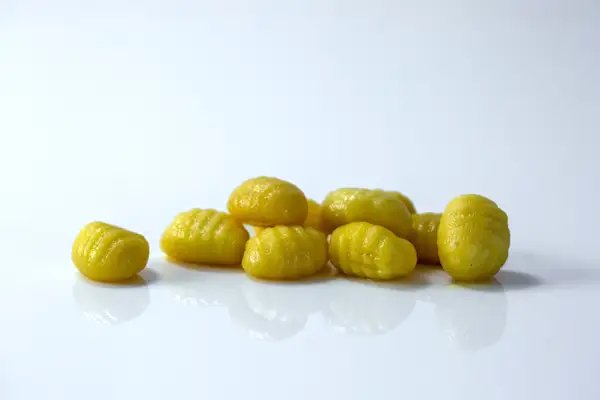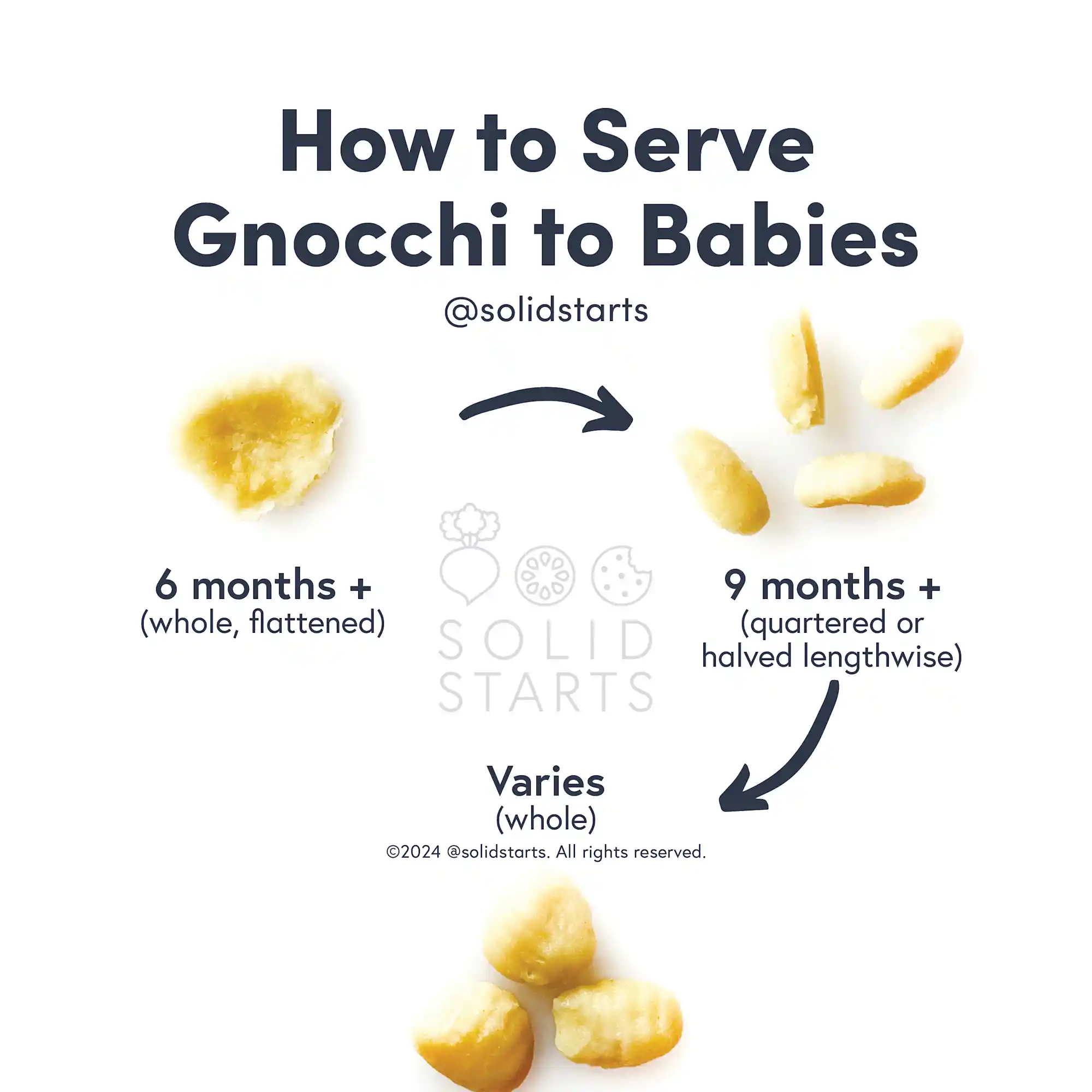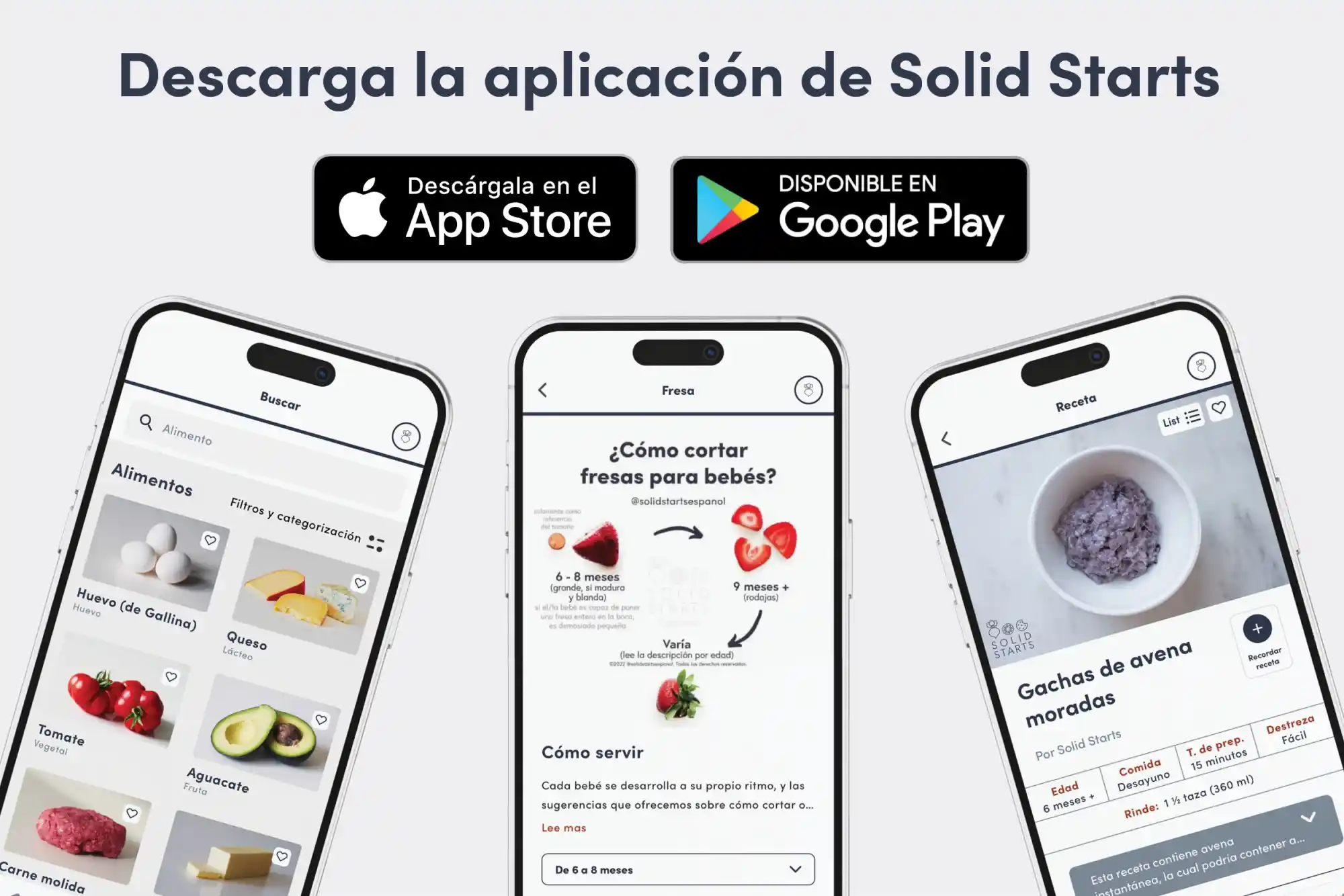Acceda a la base de datos First Foods® en Solid Starts App.
Leer másGnocchi
Comida preparada
Sugerencia de edades
6 meses
Alto contenido de hierro
No
Alérgeno común
Sí

When can babies have gnocchi?
Gnocchi may be introduced as soon as baby is ready to start solids, which is generally around 6 months of age. Note that gnocchi may contain common food allergens such as egg and wheat.
Gnocchi is a style of pasta from Italy, where its meaning of “knot” or “knuckle” alludes to its shape. To make gnocchi, flour, egg, potato, and salt are mashed and mixed to create a soft dough that can be rolled and cut into shapes. Some gnocchi are quite small, while styles like malfatti tend to be larger. Texture varies, too; some are firm from pan-frying while others are soft from boiling or steaming.
How do you serve gnocchi to babies?
Cada bebé se desarrolla a su propio ritmo, y las sugerencias que ofrecemos sobre cómo cortar o preparar determinados alimentos son generalizaciones para una amplia audiencia.
6 months old +:
Smash large, very soft cooked gnocchi until flat and offer to baby in the air or on their tray or table. Hold off on serving fried or baked gnocchi, as these are firmer and pose a higher choking risk.
9 months old +:
When you see signs of the developing pincer grasp (where the thumb and pointer finger meet), offer soft, fully cooked gnocchi cut lengthwise into halves or quarters. To further reduce choking risk, flatten the pieces to eliminate any tapered edges or cook the pieces in a liquid or sauce so that they are very soft. Share gnocchi on its own or in a sauce. At this age, some babies overstuff their mouths with food; if this happens, try serving the gnocchi pieces one at a time. Avoid cutting gnocchi into coin shapes, which pose a high risk of choking.
18 months old +:
Wait to offer whole, cooked gnocchi until you feel confident in the child’s eating skills; they need to be able to take bites, thoroughly chew food, move food around with the tongue, and not overstuff the mouth. Serving the gnocchi one piece at a time and modeling how you thoroughly chew and swallow the food may help. Gnocchi offer an excellent texture for toddlers to practice utensil use. At this age, you can also offer large, whole baked or fried gnocchi. Continue to hold off until closer to age 2 on serving smaller varieties of gnocchi when baked or fried, as these are more firm and may be more likely to be shoveled in the mouth and chewed less thoroughly.

How to serve gnocchi to babies 6 months +
Videos
Are gnocchi a choking hazard for babies?
Yes. Gnocchi are typically small, and are often quite firm and springy, which are qualities that pose a high risk of choking. To reduce the risk, make sure the gnocchi are soft and prepare and serve them in an age-appropriate way as described in the How to Serve section. As always, make sure you create a safe eating environment and stay within an arm’s reach of baby during meals.
Learn the signs of choking and gagging and more about choking first aid in our free guides, Infant Rescue and Toddler Rescue.
Do gnocchi contain common allergens?
Yes. Gnocchi are commonly made with egg and wheat, and may contain other common allergens, such as dairy and soy.
Prior to sharing gnocchi with baby, it is important to introduce common food allergens on their own and rule them out as allergens before serving them together in a prepared food. This way, you’ll be able to identify which allergen is responsible if baby has a reaction. Then, when you are ready to offer gnocchi, you will be confident that they have already safely eaten any common food allergens in the food.
As you would when introducing any new food, start by offering a small quantity for the first few servings. If there is no adverse reaction, gradually increase the quantity over future meals.
Are gnocchi healthy for babies?
Yes. Gnocchi offers plenty of carbohydrates to fuel baby’s energy for growth, play, and exploration. While some gnocchi can be high in sodium, the amount of sodium that babies eat tends to be low as they learn the skills to feed themselves, and some sodium is important for supporting baby’s electrolyte balance, hydration, and movement.
¿Qué utensilios necesito para empezar?
¡Ninguno! Sirve los alimentos sólidos directamente en la bandeja, plato o tazón del/a bebé y luego deja que el/la bebé explore con las manos. Si lo deseas, tenga una cuchara o un tenedor disponibles para ayudarlo/a a familiarizarse con los utensilios, pero no se espera que adquiera las habilidades para usarlos hasta que sea un poco mayor.
¿Es necesario tener una trona/silla alta?
Si bien una silla alta puede ayudar a crear un entorno seguro para comer, existen formas alternativas para que el/la bebé coma de forma segura, así como sostenerlo/a en tu regazo o sentarse juntos en el suelo. Para obtener más información, consulta nuestra Guía detallada de sillas altas para bebés.
Nuestro equipo
Escrito por
Consejos de expertos directo a tu bandeja de entrada
¡Suscríbete y recibe correos semanales con recetas, consejos y más!
Copyright © 2025 • Solid Starts Inc






